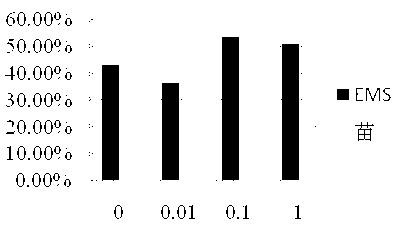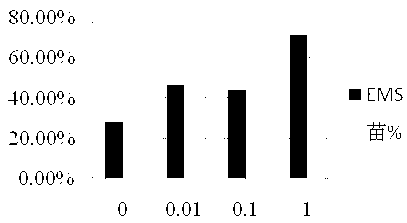Somatic embryogenesis method for cunninghamia lanceolata
A technology of embryogenesis and somatic cells, applied in horticultural methods, botanical equipment and methods, plant regeneration, etc., can solve the problems of browning, loose EMS structure, limited proliferation efficiency, etc., to save costs and solve the frequency of somatic embryos Low, the effect of improving the browning phenomenon
- Summary
- Abstract
- Description
- Claims
- Application Information
AI Technical Summary
Problems solved by technology
Method used
Image
Examples
Embodiment 1
[0038] Example 1 Induction of embryogenic stalk (EMS).
[0039] The test materials were the immature cones of the excellent Chinese fir trees collected from the seed orchards of the Chinese fir clones grafted in Shunchang and Weimin, Fujian, respectively, every week from June to July. The seed development stages corresponding to each seed collection time point were the developmental stages from immature embryo to mature embryo. After the cones are collected, put them in a pre-frozen ice box on site and wrap them with moist gauze to prevent water loss; then quickly put them in a 4°C refrigerator for storage for later use. Before inoculation, take the spare cones out of the refrigerator, use a scalpel and tweezers to take out the well-developed immature seeds with seed wings in the cones, and use Diaopai detergent rich in high-efficiency compound active agents to make a concentration of 1:50 Soak in the lotion for 10 minutes, then rinse with running water for 30 minutes. In a ...
Embodiment 2
[0041] Example 2 Maintenance and proliferation culture of EMS.
[0042] The maintenance and proliferation medium for EMS has the same composition as the basic medium for inducing EMS, but the concentration of auxin is reduced. The maintenance and proliferation culture of Chinese fir ESM uses DCR as the basic medium, supplemented with 2,4-D 2~6 mg / L, 6-BA 0.5~1.0mg / L, KT 0.5mg / L, Vc 10 mg / L, hydrolyzed casein Protein 0.5 g / L, maltose 15 g / L, Ac 2.5 g / L, crystal agaric 2.3 g / L solid medium, add PSK (0.01~1 mg / L), subculture cycle 25 days, 23 ℃, dark nourish.
[0043] It can be observed that on the proliferation medium added with PSK, the EMS stalk cells develop better and the materials disperse better.
Embodiment 3
[0044] Example 3 Development and maturation of somatic embryos.
[0045] (1) Indirect somatic embryogenesis
[0046] A. Liquid suspension culture
[0047] The liquid proliferation medium is the same as DCR as the basic medium, supplemented with 2,4-D 0.5~2 mg / L, 6-BA 0.2mg / L, glutamine 0.45 g / L, hydrolyzed casein 0.5 g / L, maltose 30g / L. The initial density of the cultured cells was 1.20% (V / V), the rotation speed of the shaker was 85~90r.p.m, and the culture was carried out at 23°C in the dark, and the time of proliferation culture was controlled to be about 7 days. And add different concentrations of PSK (0.01~1mg / L) in the liquid proliferation medium to carry out the culture test.
[0048] Liquid pretreatment medium (DCR, 5-10mg / L ABA, 0.1-1.0mg / L GA, 10mg / L vitamin C, 0.5g / L hydrolyzed casein, 30g / L maltose) to remove all additional hormones, add ABA (Abscisic acid) 5~10mg / L, stop the ESM to continue to split, and turn to the mature development process of somatic embryo...
PUM
 Login to View More
Login to View More Abstract
Description
Claims
Application Information
 Login to View More
Login to View More - R&D
- Intellectual Property
- Life Sciences
- Materials
- Tech Scout
- Unparalleled Data Quality
- Higher Quality Content
- 60% Fewer Hallucinations
Browse by: Latest US Patents, China's latest patents, Technical Efficacy Thesaurus, Application Domain, Technology Topic, Popular Technical Reports.
© 2025 PatSnap. All rights reserved.Legal|Privacy policy|Modern Slavery Act Transparency Statement|Sitemap|About US| Contact US: help@patsnap.com



